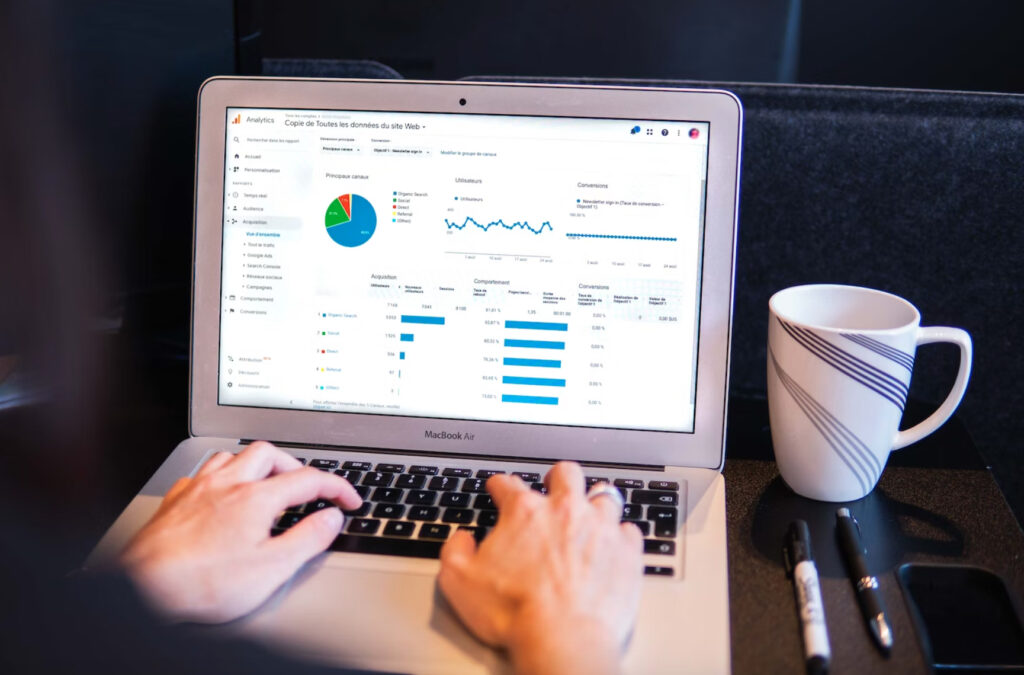Google Analytics is a free web analytics tool provided by Google that allows you to track and analyze your website’s traffic and user behavior. It provides valuable insights into how visitors interact with your website, including which pages they visit, how long they stay, and how they arrived at your site. Additionally, it provides information about your audience demographics and interests, helping you better understand who your visitors are and what they are looking for. This article discusses in detail how to use Google Analytics for better SEO.
Google Analytics is an essential tool for improving your website’s SEO and marketing efforts. By analyzing website traffic and user behavior, you can identify areas where your website can be optimized for better performance. This can include identifying which pages and keywords are driving the most traffic to your site, as well as areas where visitors may be dropping off or not engaging with your content.
Using Google Analytics to track conversion rates and bounce rates can also help you optimize your marketing efforts. You can identify which marketing channels are driving the most traffic and which are resulting in the most conversions. By tracking user demographics and interests, you can create more targeted marketing campaigns and content that better resonate with your audience.
Overall, Google Analytics provides invaluable insights that can help you make informed decisions about your website’s design, content, and marketing strategies, ultimately leading to better results and increased success.
Setting Up Google Analytics
To start using Google Analytics, you first need to create an account. Go to the Google Analytics website and sign up using your Google account. Follow the prompts to enter your website’s information, including the URL and the industry you are in. You will also need to accept the terms and conditions to proceed.
Once you have created your Google Analytics account, you will need to add the tracking code to your website. This code allows Google to collect data about your website’s traffic and user behavior.
To add the tracking code, you will need to copy the code provided by Google and paste it into the HTML code of your website’s header. This can be done manually if you have access to your website’s code, or you can use a plugin or extension if you are using a content management system like WordPress or Shopify.
Once the tracking code is added to your website, it may take up to 24 hours for Google Analytics to start collecting data. After this time, you can log in to your Google Analytics account to start analyzing your website’s traffic and user behavior.
Using Google Analytics for Better SEO Insights
Google Analytics provides a wealth of information about your website’s traffic. This includes data on the number of visitors, pageviews, and sessions. You can also see where your traffic is coming from, whether it’s from organic search, social media, or referral links.
By understanding your website’s traffic, you can identify which channels are driving the most visitors to your site. This can help you prioritize your SEO efforts and focus on optimizing the channels that are most effective for your business.
Google Analytics also provides data on user behavior, including the amount of time visitors spend on your website, the pages they visit, and the actions they take. You can also see the bounce rate, which shows the percentage of visitors who leave your website after only viewing one page.
By analyzing user behavior, you can identify which pages and content are most engaging for your visitors. This can help you optimize your website’s content and design to improve user experience and encourage visitors to stay on your website longer.
Google Analytics also allows you to identify your website’s top-performing pages and keywords. By looking at data on pageviews and traffic sources, you can identify which pages and keywords are driving the most traffic to your site.
This information can be used to optimize your website’s content and keywords to better target your audience and improve your SEO performance. You can also identify areas where your website may be underperforming and make adjustments to improve your overall SEO strategy.
Using Google Analytics for Marketing Insights
Google Analytics can help you track your website’s conversion rate, which is the percentage of visitors who complete a desired action, such as making a purchase, filling out a form, or signing up for a newsletter.
By tracking conversion rates, you can identify which pages and marketing channels are most effective at driving conversions. You can also test different elements of your website, such as headlines, calls-to-action, and landing pages, to see which variations lead to the highest conversion rates.
The bounce rate is the percentage of visitors who leave your website after viewing only one page. A high bounce rate can indicate that your website is not engaging visitors or that it is not meeting their expectations.
By analyzing the bounce rate, you can identify areas where your website may be underperforming and make adjustments to improve user experience. You can also look at the bounce rate for different pages and marketing channels to identify areas where you may need to make changes to improve engagement.
Google Analytics can also provide information on your website’s user demographics and interests. This includes data on age, gender, location, and interests.
By understanding your audience demographics and interests, you can create more targeted marketing campaigns and content that resonates with your audience. You can also identify areas where your website may not be effectively reaching your target audience and make changes to improve your marketing efforts.
Overall, by using Google Analytics for marketing insights, you can improve your website’s performance and optimize your marketing efforts for better results.


